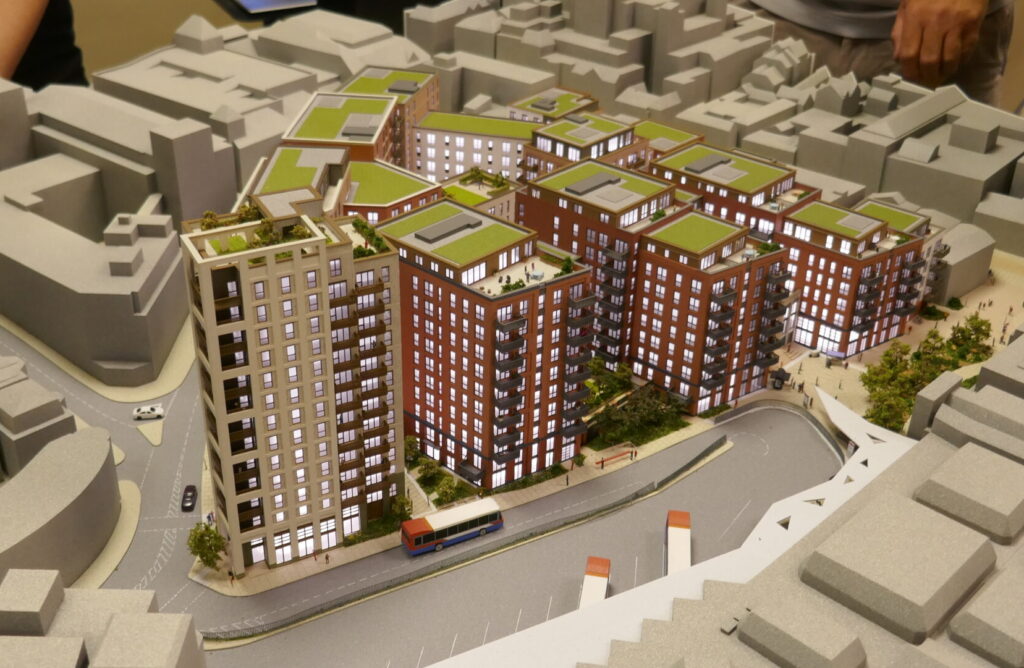 Abraham Lincoln
If given the truth, the people can be depended upon to meet any national crisis...
Abraham Lincoln
If given the truth, the people can be depended upon to meet any national crisis...
 Guildford news...
for Guildford people, brought to you by Guildford reporters - Guildford's own news service
Guildford news...
for Guildford people, brought to you by Guildford reporters - Guildford's own news service
Opinion: Our Economy Needs the North Street Project and People Need Homes
Published on: 31 Aug, 2022
Updated on: 3 Sep, 2022
lead borough councillor for Regeneration and R4GV ward councillor for Holy Trinity
I agree with much of Martin Giles’ opinion piece In My Heart I Knew It Was a Forlorn Hope.
I agree we should have a height restriction. It was not included in the infamous Local Plan of 2019, nor advocated or supported by others for inclusion in the latest Development Management policies.
However, it has to be recognised that the proposed heights are not universally resented by the community, especially in this location.
I also agree that the planning appeal system makes it very expensive for councils to turn down applications. There have to be good planning grounds to safely reject an application. A sizeable proportion of the community disliking a proposal is not a valid reason. It can cost GBC hundreds of thousands of pounds in costs when rejected applications are won by the developer on appeal.

The model presented at the recent exhibition of the proposal for the North Street Regeneration, project “The Friary Quarter”.
When it comes to the question of traditional styling, I like it too. I do not agree with architects’ sweeping dismissal of traditional design as “just pastiche”. How many celebrated 19th or 20th Century civic buildings in the world are “just pastiche” of early Greek or Roman designs?
The use of local materials such as Bargate stone, or flint or clay-hung tiles, is also important in Guildford. It would not hurt the developer to indulge us to a degree. With so many different buildings in this project, a mix of styles can add interest.
See also: Dragon Editor Debates Guildford Planning with Council Leader on Radio Surrey
Personally, l would also like more character to the facades of the buildings, more design features and ones unique to Guildford. Then we wouldn’t have only a photograph of the Guildhall clock with which to identify our town.
However, in the project’s defence:
We desperately need homes in the heart of our town. This scheme can house 1,000 people in a great location, close to the High Street and bus and railway stations. Thanks to the scheme heights, many will have views over the bus station and the Friary shopping centre to the wonderful Surrey Hills beyond.
Any scheme must be viable. There have been eight failed attempts over 30 years to bring forward this site. I believe seeking perfection from a project design can be the enemy of progress.
Developers already have to cope with volumes of planning rules and regulations. Everything from new building regulations, biodiversity, contamination, water quality and water management, protection of amenity, public realm, noise impact, climate change, carbon emissions, parking standards, heritage, conservation, open space and community facilities. The list goes on and on plus, of course, there is the South East Design Panel to navigate.
The North Street site was allocated in the 2019 Local Plan for up to 40,000 sq m (400,000 sq ft) of retail space, with 400 homes set atop the development. The outdated retail allocation, even if developed in 2019, would have been truly a white elephant. The residential element with the retail content would have meant us heading for double the current proposed massing.
After a lot of hard work over the past three years, the scheme is now reduced to 475 apartments, with 2,000 sq m (20,000 sq ft) of ground floor restaurants, retail and other uses. Storey heights may appear high but the developer has been pushed hard.
Once the size of the development has been set, there is a limit to what the apartments will sell at and what can be afforded after costs are covered.
This scheme has to cover the cost, among others, of underground car parking, a new bus station and a new road network. There will be entry and exit to the new bus station from Leapale Road only.
See also: Ten Blocks of Flats in North Street Would Overwhelm the Townscape
The major benefit is this decision removes thousands of bus movements currently forced to drive south on Onslow Street, around the Friary Shopping Centre, to enter into the congested gyratory then into lower North Street.
At this point the buses currently cross and are in conflict with the main pedestrian route from the High Street and Friary Street to the Friary shopping centre, bringing health and safety concerns plus pollution.
The buses then enter Commercial Road to drive back north again up to the bus station to park. Removing this particular bus gyratory pattern can be an enormous environmental win compared to the current arrangements.
The removal of the buses and closure of North Street to traffic can transform the street wonderfully for families and visitors to enjoy, with an improved marketplace. New green spaces and squares to be created will be an important addition to our town.
 If we do not bring forward brownfield sites like this through regeneration then it means building again on the green belt. This inevitably leads to an increased dependency on the motor car. We know central government insists we deliver homes, while providing none of the necessary connecting infrastructure.
If we do not bring forward brownfield sites like this through regeneration then it means building again on the green belt. This inevitably leads to an increased dependency on the motor car. We know central government insists we deliver homes, while providing none of the necessary connecting infrastructure.
Another big win is the arrival of a new neighbourhood to help sustain retailers in the town centre. Homes for 1,000 people in a location vacant for 30 years is important and whether under a pitched roof or a flat roof I doubt the occupiers will mind too much, they want a home.
However, the pressure post-Covid to have balconies and roof terraces has grown since the lock downs as has the interest in green roofs.
But we are not home and dry.
There are those determined to block the proposal with every possible argument, or even just to delay its consideration by the planning committee. Large schemes like this often fail because it takes years to arrive at a viable, deliverable scheme.
This proposal has taken four years to reach the formal application stage. By the time schemes are consented, a property or economic recession can arrive and the scheme collapses as viability fails.
Here we are again, with rampant inflation, rising interest rates and the faltering housing market.
That’s why the absence of Bargate stone will not be uppermost in my mind, compared to making progress with the project and trying to get it over the line despite those who would delay or block this project.
Guildford’s economy desperately needs schemes like this and people need homes.
Responses to Opinion: Our Economy Needs the North Street Project and People Need Homes
Leave a Comment Cancel replyPlease see our comments policy. All comments are moderated and may take time to appear. Full names, or at least initial and surname, must be given.
Recent Articles
- Surrey Councils Call on Residents to Recycle All Their Food Waste
- Windfall Grant Allows High Street Redevelopment Project to Proceed
- New Crossing at Burpham
- Young Councillor Quits Tories for Reform
- Surrey Police Crackdown Shows Serious Rise In Drug-Driving
- Letter: Too Many Years Have Been Lost Awaiting This Decision
- Guildford’s First “Living School Gate” Delivers Major Health and Environmental Benefits
- Flashback: Church Says Plans Are Progressing Well In Bid To Sell Off Graveyard
- Letter: Council Should Use Computer Modelling When Deciding Harm of Planning Applications
- Letter: The National Trust Needs to Speed Up


Recent Comments
- David Roberts on Letter: Shaping Guildford’s Future and Meeting the New Housing Uplift
- Frank Ayling on Cold War Fighter Jet Collision Over Guildford
- Simon Vine on Birdwatcher’s Diary No.318 Some Pre-Christmas Rambles
- RWL Davies on County Council Elections ‘Must Go Ahead’ Say Surrey Council Leaders
- S Callanan on Letter: The National Trust Should Be Embarrassed About How Long the Weir Repair Is Taking
- Olly Azad on Sara Sharif Trial Verdicts – Father and Stepmother Guilty of Murder of Ten-year-old Daughter
Search in Site
Media Gallery
Dragon Interview: Local Artist Leaves Her Mark At One of England’s Most Historic Buildings
January 21, 2023 / No Comment / Read MoreDragon Interview: Lib Dem Planning Chair: ‘Current Policy Doesn’t Work for Local People’
January 19, 2023 / No Comment / Read MoreA3 Tunnel in Guildford ‘Necessary’ for New Homes, Says Guildford’s MP
January 10, 2023 / No Comment / Read More‘Madness’ for London Road Scheme to Go Ahead Against ‘Huge Opposition’, Says SCC Leader
January 6, 2023 / No Comment / Read MoreCouncillor’s Son Starts Campaign for More Consultation on North Street Plan
December 30, 2022 / No Comment / Read MoreCounty Council Climbs Down Over London Road Works – Further ‘Engagement’ Period Announced
December 14, 2022 / No Comment / Read MoreDragon Interview: GBC Reaction to the Government’s Expected Decision to Relax Housing Targets
December 7, 2022 / No Comment / Read MoreHow Can Our Town Centre Businesses Recover? Watch the Shop Front Debate
May 18, 2020 / No Comment / Read More












Bibhas Neogi
August 31, 2022 at 3:15 pm
Cllr Rigg said: ” There will be entry and exit to the new bus station from Leapale Road only……The major benefit is this decision removes thousands of bus movements currently forced to drive south on Onslow Street, around the Friary Shopping Centre, to enter into the congested gyratory then into lower North Street.” (Woodbridge Road actually unless Leapale Road is extended to replace this stretch).
True, but all the transport modelling has not examined the possible locking up of York Road roundabout because of buses turning around the roundabout possibly blocking all lanes on it as their exit into Woodbridge Road is not clear.
Cllr Rigg continued to say “The buses then enter Commercial Road to drive back north again up to the bus station to park. Removing this particular bus gyratory pattern can be an enormous environmental win compared to the current arrangements.” I agree it would be better but there is a reason for this design and that is buses from the south and the west do not have to turn around York Road roundabout.
I think a trial should be carried out to find out the effect of this altered entry and exit off Woodbridge Road. Tailbacks blocking the gyratory are a daily occurrence and it should not be repeated at the already congested York Road roundabout.
I am not too concerned about the height provided the upper apartments are accessible to Guildford’s Fire Service. The tallest ladder available currently, I believe, is 45 meters. This would reach the height of the tallest building but access around it and other buildings of lesser heights needs to be satisfactory. It looks a bit cramped though for such access.
Bibhas Neogi
December 23, 2022 at 11:31 am
A few months on from this article, there is no news of GBC’s two independent reports that Cllr John Rigg claimed showed that the proposed traffic movements around the development area and for the buses entering and exiting the bus station worked OK. When will the findings be made public?
SCC and the bus operators opposed the proposed traffic movements around the development area and the access to the bus station from the northern end. St Edwards was discussing options with SCC. Is SCC now content with the proposals or is there a different solution that has been agreed?
I believe satisfactory solutions exist and I do have sketches showing these alterations but I am not making them available unless either GBC or St Edwards asks for them. I believe they are worth exploring and they also allow new cycle lanes and access from this area to the town centre and possibly to the railway station but cyclists dismounting at pedestrian crossings.